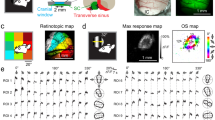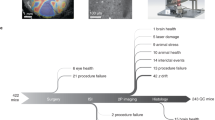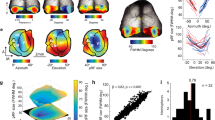Abstract
Voltage-sensitive dyes allow neuronal activity to be studied by non-invasive optical techniques. They provide an attractive means of investigating striate cortex, where important response properties are organized in two dimensions. In the present study, patterns of ocular dominance and orientation selectivity were obtained repeatedly from the same patch of cortex using the dye merocyanine oxazolone, together with current image-processing techniques. The patterns observed agree with most established features of monkey striate cortex and suggest a new unit of cortical organization; one that is modular in structure and which appears to link the organization of orientation selectivity with that of ocular dominance.
This is a preview of subscription content, access via your institution
Access options
Subscribe to this journal
Receive 51 print issues and online access
$199.00 per year
only $3.90 per issue
Buy this article
- Purchase on Springer Link
- Instant access to full article PDF
Prices may be subject to local taxes which are calculated during checkout
Similar content being viewed by others
References
Hubel, D. H. & Wiesel, T. N. J. Physiol., Lond. 160, 106–154 (1962).
Hubel, D. H. & Wiesel, T. N. J. Neurophysiol. 28, 229–289 (1965).
Hubel, D. H. & Wiesel, T. N. J. Physiol., Lond. 195, 215–243 (1968).
Hubel, D. H. & Wiesel, T. N. Nature 225, 41–42 (1970).
Hubel, D. H. & Wiesel, T. N. J. comp. Neurol. 146, 421–450 (1972).
Hubel, D. H. & Wiesel, T. N. J. comp. Neurol. 158, 295–306 (1974).
Hubel, D. H. & Wiesel, T. N. J. comp. Neurol. 158, 267–294 (1974).
Hubel, D. H. & Wiesel, T. N. Proc. R. Soc. B198, 1–59 (1977).
LeVay, S., Hubel, D. H. & Wiesel, T. N. J. comp. Neurol. 159, 559–576 (1975).
Fitzpatrick, D., Lund, J. S. & Blasdel, G. J. Neurosci. 5, 3329–3349 (1984).
Sillito, A. M. in Cerebral Cortex Vol. 2 (eds Jones, E. G. & Peters, A.) 91–118 (Plenum, New York, 1984).
Hubel, D. H., Wiesel, T. N. & Stryker, M. J. comp. Neurol. 177, 361–380 (1978).
Horton, C. H. & Hubel, D. H. Nature 292, 762–764 (1981).
Humphrey, A. L. & Hendrickson, A. E. J. Neurosci. 3, 345–358 (1983).
Livingstone, M. S. & Hubel, D. H. J. Neurosci. 4(1), 309–356 (1984).
Davila, H. V., Salzberg, B. M., Cohen, L. B. & Waggoner, A. S. Nature new Biol. 241, 159–161 (1973).
Salzberg, B. M., Davila, H. V. & Cohen, L. B. Nature 246, 508–509 (1973).
Cohen, L. B. et al. J. Membrane Biol. 19, 1–360 (1974).
Ross, W. N. et al. J. Membrane Biol. 33, 141–183 (1977).
Morad, M. & Salama, G. J. Physiol., Lond. 292, 267–295 (1979).
Cohen, L. B. & Salzberg, B. M. Rev. Physiol. Biochem. Pharmac. 83, 35–83 (1978).
Salzberg, B. M. Curr. Meth. cell. Neurobiol. 3, 139–187 (1983).
Orbach, H. S., Cohen, L. B. & Grinvald, A. J. Neurosci. 5, 185–195 (1985).
Salzberg, B. M., Grinvald, A., Cohen, L. B., Davila, H. V. & Ross, W. N. J. Neurosci. 40, 1281–1286 (1977).
Grinvald, A., Cohen, L. B., Lesher, S. & Boyle, M. B. J. Neurophysiol. 45, 829–840 (1981).
Salama, G., Sanger, T. & Cohen, L. B. Biol. Bull. 161, 316 (1981).
Blasdel, G. G. & Fitzpatrick, D. J. Neurosci. 4, 880–895 (1984).
Sokoloff, L. CIBA Fdn Symp. 56, 171–197 (1978).
Kelley, J. P. & Van Essen, D. C. J. Physiol., Lond. 238, 515–574 (1974).
Ross, W. N. & Reichardt, L. F. J. Membrane Biol. 48, 343–356 (1979).
Nakajima, S. & Gilai, A. J. gen. Physiol. 76, 729–750 (1980).
Heiny, J. A. & Vergara, J. J. gen. Physiol. 85, 805–837 (1984).
Braitenberg, V & Braitenberg, C. Biol. Cybernet. 33, 179–186 (1979).
Rockland, K. S. & Lund, J. S. J. comp. Neurol. 216, 303–313 (1983).
Livingstone, M. S. & Hubel, D. H. J. Neurosci. 4, 2830–2835 (1984).
Wong-Riley, M. Brain Res. 162, 201–217 (1979).
Author information
Authors and Affiliations
Rights and permissions
About this article
Cite this article
Blasdel, G., Salama, G. Voltage-sensitive dyes reveal a modular organization in monkey striate cortex. Nature 321, 579–585 (1986). https://doi.org/10.1038/321579a0
Received:
Accepted:
Issue Date:
DOI: https://doi.org/10.1038/321579a0
This article is cited by
-
Stimulus edges induce orientation tuning in superior colliculus
Nature Communications (2023)
-
Induction of excitatory brain state governs plastic functional changes in visual cortical topology
Brain Structure and Function (2023)
-
Form, synapses and orientation topography of a new cell type in layer 6 of the cat’s primary visual cortex
Scientific Reports (2022)
-
Cone opponent functional domains in primary visual cortex combine signals for color appearance mechanisms
Nature Communications (2022)
-
Processing of visual statistics of naturalistic videos in macaque visual areas V1 and V4
Brain Structure and Function (2022)
Comments
By submitting a comment you agree to abide by our Terms and Community Guidelines. If you find something abusive or that does not comply with our terms or guidelines please flag it as inappropriate.



